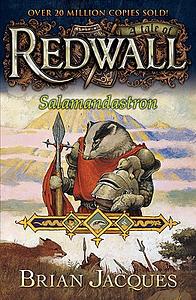You need to sign in or sign up before continuing.
Take a photo of a barcode or cover
This is not one of my favorites. It may be because it's one of the earlier ones but it's quite a bit more gruesome. I didn't find Mara and Pikkle to be very intelligent, though I liked both by the end. Still enjoyable as always.
adventurous
funny
inspiring
medium-paced
Plot or Character Driven:
Character
Strong character development:
Yes
Loveable characters:
Yes
Diverse cast of characters:
Yes
Flaws of characters a main focus:
Yes
This entry is the first in the series that truly gives the entire "Redwall" experience. Multiple story lines that come together in interesting ways, the Abbey facing an internal threat, young heroes forming lasting bonds, unlikely allies, and as always wonderful feasts and season name days.
Jacques is a true master story teller, this is the type of yarn that is told around a campfire with good food and drink near at hand. He finds his stride, and his pose in this novel, and rarely misses it after. An page turning entry in the series and one of my favorites!
Jacques is a true master story teller, this is the type of yarn that is told around a campfire with good food and drink near at hand. He finds his stride, and his pose in this novel, and rarely misses it after. An page turning entry in the series and one of my favorites!
adventurous
hopeful
inspiring
lighthearted
medium-paced
Plot or Character Driven:
Plot
Strong character development:
No
Loveable characters:
Yes
Thrugg and Dungle won my heart.
I didn't notice the main plotflow of the story for the most part (I have a habit of zoning out on books from time to time), but when I heard about the disease, Dryditch fever, my little ten-year-old mind went into a panic. I've always had a great fear about getting some kind of horrible incurable infectious disease, and Dryditch is just the kind of thing that got my little heart racing (I'm more worried about Ebola these days). Then of course Thrugg comes along; otters everywhere are my weak point and he was no different. Dungle of course had the perfect adorable little dibbun name which I just loved to pronounce. I may have ignored the main plot of this story the first couple times I read it, but trust me. Thrugg and Dungle alone are worth the stars.
I didn't notice the main plotflow of the story for the most part (I have a habit of zoning out on books from time to time), but when I heard about the disease, Dryditch fever, my little ten-year-old mind went into a panic. I've always had a great fear about getting some kind of horrible incurable infectious disease, and Dryditch is just the kind of thing that got my little heart racing (I'm more worried about Ebola these days). Then of course Thrugg comes along; otters everywhere are my weak point and he was no different. Dungle of course had the perfect adorable little dibbun name which I just loved to pronounce. I may have ignored the main plot of this story the first couple times I read it, but trust me. Thrugg and Dungle alone are worth the stars.
I sound like a broken record talking about Redwall, but I don't care: this is one of the best in the series (just like all the others). The characters are realized, and the plot is well-structured, but it has distinct moments to it that elevate it. The B-Plot is a rare one to feel just as tense, yet unique and separate from the A-Plot. I think one of the best parts of this book is that I struggle with what else to say for risk of spoilers, which I never want to include in a review. Seriously, there aren't many books in this series I can confidently say have moments you don't want spoiled, but this book's got 'em. So in conclusion: good plot, good characters, good moments, great book. This is a top fiver.
Ferahgo the Assassin is my favorite Redwall villain.
adventurous
dark
funny
lighthearted
slow-paced
Plot or Character Driven:
A mix
Strong character development:
No
Loveable characters:
N/A
Diverse cast of characters:
Yes
Flaws of characters a main focus:
No
adventurous
lighthearted
medium-paced
Plot or Character Driven:
Plot
Strong character development:
Yes
Loveable characters:
Yes
Diverse cast of characters:
N/A
Flaws of characters a main focus:
Complicated
(I finished this a month ago and should have reviewed it back then, but I was more interested in diving into my next book than writing a review.)
Salamandastron follows multiple groups of characters whose paths eventually converge. The primary storyline starts at Salamandastron. Ferahgo, a blue-eyed assassin weasel, has set his sights on that place and is convinced that there is great treasure to be found there. He knows it’ll all belong to him if he and his band can manage to defeat Urthstripe, the great badger Lord, and his skilled warrior hares. Urthstripe, meanwhile, is distracted by family problems: Mara, his adopted daughter, has been growing increasingly rebellious and restless.
The secondary storyline starts at Redwall Abbey. Everything there is good food and celebrations, with occasional light punishments for scamps like Samkim the squirrel and his best friend Arula the molemaid, until a couple stoats accidentally do something horrible. Suddenly Samkim finds himself suspected of killing someone. As if that wasn’t bad enough, many of Redwall Abbey’s residents then fall ill with the dreaded Dryditch Fever.
This is the first Redwall book I’ve ever read. I had planned to start with Redwall, the very first book in the series, but my copy was used and fell apart in my hands when I opened it up. After a little searching online, I determined that I should be able to start with Salamandastron, the one other Redwall book I owned, without becoming too confused.
Salamandastron was given to me by a friend back when I was, I think, in middle school. If I had read it back then, I might have liked it more. Despite its copious amounts of (not explicitly described) violence and death, Salamandastron definitely read like it was meant for a younger audience - I’m guessing either the high end of the Middle Grade age range or the low end of the Young Adult.
Then again, who knows? Maybe the various accents in Salamandastron would have annoyed Younger Me too. The moles were definitely the worst, although the falcons and eagle occasionally gave me trouble too. Here’s an example that made me laugh bitterly - a mole saying he had trouble understanding an eagle:
Oh really. And how do you think I felt every time one of the moles opened their mouths? There were times I just gave up and skimmed certain characters’ dialogue. Why did Samkim’s best friend have to be a mole? ::sob::
I can totally see younger readers being drawn in by the anthropomorphized animals and action scenes. And food descriptions! This book was chock full of delicious-sounding food. Unfortunately, sometimes all that food and eating detracted from the story. For example, at one point Mara’s friend Pikkle took part in an eating contest. This was after he and Mara had nearly been eaten by carnivorous toads. Not to mention, Mara and Pikkle should still have been worried sick about what Ferahgo and his band might be doing to their friends and family back at Salamandastron. But no, figuring out who could eat the most hot spiced apple pudding was suddenly the most important thing.
This was part of the reason why the book read so young: serious stuff happened, but it didn’t seem to have as much emotional impact as it should. Several good characters died! At least one of them senselessly! And one villain’s fate was saved from being gruesome only because most of it happened off-page and none of it was described in detail. If the other Redwall books have body counts similar to this one, I don’t think it’d be too out of line to say that Brian Jacques is the George R.R. Martin of Middle Grade fantasy.
But, again, those deaths didn’t have much emotional impact. Beloved friends and family died, and characters moved on within a page or two and were soon back to happily gorging themselves on delicious festival foods.
Meh. I had hoped to fall in love with this series, but Salamandastron has left me with no desire to try more.
Additional Comments:
I couldn’t figure out how to fit it into the body of my review, but I wanted to mention it anyway: I have never seen so many characters practice such terrible weapons safety in a single book. Samkim liked to shoot arrows wherever, just for fun, and all the adults around him did was ground him and then worry they were being too harsh. And one character, an adult who should have known better, straight up stabbed himself (not fatally, but still) because he’d been playing around with a sword like it was a toy.
Rating Note:
I gave this 1.5 stars on LibraryThing and Booklikes and rounded down to 1 star for Goodreads because it just didn't interest me enough for 2 stars to be appropriate.
(Original review posted on A Library Girl's Familiar Diversions.)
Salamandastron follows multiple groups of characters whose paths eventually converge. The primary storyline starts at Salamandastron. Ferahgo, a blue-eyed assassin weasel, has set his sights on that place and is convinced that there is great treasure to be found there. He knows it’ll all belong to him if he and his band can manage to defeat Urthstripe, the great badger Lord, and his skilled warrior hares. Urthstripe, meanwhile, is distracted by family problems: Mara, his adopted daughter, has been growing increasingly rebellious and restless.
The secondary storyline starts at Redwall Abbey. Everything there is good food and celebrations, with occasional light punishments for scamps like Samkim the squirrel and his best friend Arula the molemaid, until a couple stoats accidentally do something horrible. Suddenly Samkim finds himself suspected of killing someone. As if that wasn’t bad enough, many of Redwall Abbey’s residents then fall ill with the dreaded Dryditch Fever.
This is the first Redwall book I’ve ever read. I had planned to start with Redwall, the very first book in the series, but my copy was used and fell apart in my hands when I opened it up. After a little searching online, I determined that I should be able to start with Salamandastron, the one other Redwall book I owned, without becoming too confused.
Salamandastron was given to me by a friend back when I was, I think, in middle school. If I had read it back then, I might have liked it more. Despite its copious amounts of (not explicitly described) violence and death, Salamandastron definitely read like it was meant for a younger audience - I’m guessing either the high end of the Middle Grade age range or the low end of the Young Adult.
Then again, who knows? Maybe the various accents in Salamandastron would have annoyed Younger Me too. The moles were definitely the worst, although the falcons and eagle occasionally gave me trouble too. Here’s an example that made me laugh bitterly - a mole saying he had trouble understanding an eagle:
“‘Och, these vittles are braw eatin’, Dumble. Ha’ ye nae mair o’ these wee veggible pasties the guid hedgepig lady made?’
Droony squinched his eyes until they nearly disappeared into his small velvety face. ‘Bohurr, you’m heagle do be a-talken funny loik. Oi carn’t unnerstan’ a wurd ‘ee be sayen, Dumble.’” (290)
Oh really. And how do you think I felt every time one of the moles opened their mouths? There were times I just gave up and skimmed certain characters’ dialogue. Why did Samkim’s best friend have to be a mole? ::sob::
I can totally see younger readers being drawn in by the anthropomorphized animals and action scenes. And food descriptions! This book was chock full of delicious-sounding food. Unfortunately, sometimes all that food and eating detracted from the story. For example, at one point Mara’s friend Pikkle took part in an eating contest. This was after he and Mara had nearly been eaten by carnivorous toads. Not to mention, Mara and Pikkle should still have been worried sick about what Ferahgo and his band might be doing to their friends and family back at Salamandastron. But no, figuring out who could eat the most hot spiced apple pudding was suddenly the most important thing.
This was part of the reason why the book read so young: serious stuff happened, but it didn’t seem to have as much emotional impact as it should. Several good characters died! At least one of them senselessly! And one villain’s fate was saved from being gruesome only because most of it happened off-page and none of it was described in detail. If the other Redwall books have body counts similar to this one, I don’t think it’d be too out of line to say that Brian Jacques is the George R.R. Martin of Middle Grade fantasy.
But, again, those deaths didn’t have much emotional impact. Beloved friends and family died, and characters moved on within a page or two and were soon back to happily gorging themselves on delicious festival foods.
Meh. I had hoped to fall in love with this series, but Salamandastron has left me with no desire to try more.
Additional Comments:
I couldn’t figure out how to fit it into the body of my review, but I wanted to mention it anyway: I have never seen so many characters practice such terrible weapons safety in a single book. Samkim liked to shoot arrows wherever, just for fun, and all the adults around him did was ground him and then worry they were being too harsh. And one character, an adult who should have known better, straight up stabbed himself (not fatally, but still) because he’d been playing around with a sword like it was a toy.
Rating Note:
I gave this 1.5 stars on LibraryThing and Booklikes and rounded down to 1 star for Goodreads because it just didn't interest me enough for 2 stars to be appropriate.
(Original review posted on A Library Girl's Familiar Diversions.)
adventurous
mysterious
fast-paced







